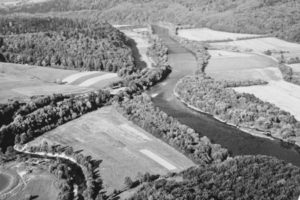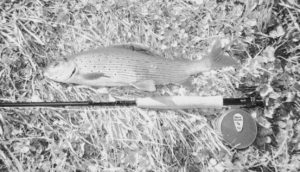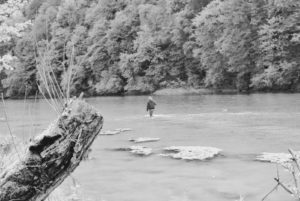 Several Augusts past, a small group of dissolute regulars was gathered at the communal long table of my New York angling club for lunch, to imbibe in a wee dram and exchange the customary dubious tales of fishing exploits and expectations. Someone posited “So, anyone got any interesting trips coming up”.
Several Augusts past, a small group of dissolute regulars was gathered at the communal long table of my New York angling club for lunch, to imbibe in a wee dram and exchange the customary dubious tales of fishing exploits and expectations. Someone posited “So, anyone got any interesting trips coming up”.
I took the bait. “Actually, yeah. I’m going to Poland next month”
“Poland? What do you catch there? Gefilte fish?”
“Wouldn’t it be easier to just go to Buffalo?”
“Maybe when you’re there you can find out how many Poles it takes to…..?”
As tasty as the club’s food is, I’m not sure that it’s worth the verbal abuse that often stalks the long table. But, come September, off I went. After some sightseeing in Warsaw I flew southeast to Rzeszów, a city in the Carpathian foothills, about 35 miles equidistant from the borders with Slovakia and the Ukraine. From the latter part of the 18th Century until the end of WWI, this region was included in the Austrian Empire (with the rest of the former Poland being split between Prussia and, Russia), then was part of an independent Poland for the two decades between the wars, until it was invaded and occupied by the Russians just two weeks after the better-known German invasion of Poland in September 1939. Later during WWII, the Russian occupiers were supplanted by the Germans, then from 1945 until 1990 a communist government directed from Russia was in control, after which Poland became a democratic republic once again. A dismal history indeed. During those long periods of occupation and subjugation many Poles left the country for greener pastures, particularly the U.S. In fact, until recently, the Polish community in Chicago was larger than Warsaw.
 On Saturday afternoon, I wandered into Rzeszów’s town square, lined with outdoor bars and restaurants, to discover that a music festival had just begun, featuring local song and dance groups, both folk and classical. Most of the classical music was by Frédéric Chopin, the famed 19th Century composer and pianist who was one of history’s great musical prodigies and continues to be a revered Polish national hero, despite the fact that he left the country at age twenty, became a French citizen, and never again returned. The festival was capped off with a free concert by Andrzej Cierniewski, a senior citizen and one of the Country’s most popular entertainers, who might be described as the Polish Neil Diamond, except for the fact that Diamond himself is of Polish heritage. In any event, the audience, which packed the square, reacted to Cierniewski with similar loud enthusiasm, as did I. So good, so good!
On Saturday afternoon, I wandered into Rzeszów’s town square, lined with outdoor bars and restaurants, to discover that a music festival had just begun, featuring local song and dance groups, both folk and classical. Most of the classical music was by Frédéric Chopin, the famed 19th Century composer and pianist who was one of history’s great musical prodigies and continues to be a revered Polish national hero, despite the fact that he left the country at age twenty, became a French citizen, and never again returned. The festival was capped off with a free concert by Andrzej Cierniewski, a senior citizen and one of the Country’s most popular entertainers, who might be described as the Polish Neil Diamond, except for the fact that Diamond himself is of Polish heritage. In any event, the audience, which packed the square, reacted to Cierniewski with similar loud enthusiasm, as did I. So good, so good!
The next morning Richard, my guide, picked me up and we drove for an hour to a house where I was to stay on the lower San River, which flows out of a reservoir, near the Bieszczady National Park – a major wilderness area. He told me that he had previously lived in Afghanistan, South Africa and Costa Rica, then for over twenty years in Chicago, returning to his village in Poland a few years earlier to care for his parents. He had a steady stream of exotic stories, or perhaps tall tales. When we arrived at the house, he asked to examine my flies. I showed him a typical assortment of common patterns, but also two boxes of tiny flies that I use on a few spring creeks and tail waters, when I don’t want to catch any fish. Surprisingly, he was most impressed with this collection of mysterious miniatures, noting that “no one ever brings flies like those here.”
 Being astute, I immediately grasped the importance of Richard’s observation. If no one ever brought flies like those, then the fish had never seen their like. They would be easily inveigled and, perhaps, I would become a legend of the San. The American who untied the piscatorial Gordian Knot. The fishing hadn’t even started and I was already flushed with success.
Being astute, I immediately grasped the importance of Richard’s observation. If no one ever brought flies like those, then the fish had never seen their like. They would be easily inveigled and, perhaps, I would become a legend of the San. The American who untied the piscatorial Gordian Knot. The fishing hadn’t even started and I was already flushed with success.
The house is managed by Wojtek, an owner of the guiding operation. He shops, cooks, cleans, occasionally guides and oversees his two young children while his wife works and lives during the week three hours away in Kraków. I met Dadek, his tow-headed two-year old son who constantly referred to himself in the first person as “Bebish”, for reasons that only he understood. Bebish and I got along famously because my half dozen words of Polish were among the few dozen that he had mastered. During the week, an interesting collection of other guests – an American, a Brit, two Frenchmen and a Pole – showed up, seemingly unannounced. Some days one of them would fish with me, and at night they consumed prodigious quantities of vodka, the mother’s milk of Poland.
The first morning we futzed around after breakfast before finally leaving to fish at well past ten o’clock. As always at the start of a trip, I was a bit antsy, but as the week moved along, it became clear that there was no reason to get going early. The River’s six-mile fishing section is divided into eight designated beats, and to fish them requires obtaining a special permit each day. The first day, we stopped at the house of a forest ranger to get our assigned beat. When we arrived at our beat, two cars were already parked there and several anglers were in the water casting in earnest. No worries, Richard drove around until he found another beat that was empty and we fished there. This strange ritual repeated itself for all six days that I fished, with other anglers always at our assigned beat, but with another beat (that was assigned to someone else) always being empty and available. And I never had to fish the same beat twice. But I did wonder why they bothered assigning beats. Perhaps it’s like screwing in a lightbulb.
The San, and its large population of brown trout and grayling, was a local secret until 1985 when the World Fly Fishing Championship was held there. As stories of the competitors’ success spread, anglers from all over Europe began flocking there. Because there were no fishing regulations, the fish population was decimated in a few years. In the early 90s regulations were implemented and, today, it has a very large population of fish – perhaps too large.
The World Championship returned to the San in June, 2010. Poland has twice won the gold medal, trailing well behind the leader, the Czech Republic which has won nine, followed by France, Italy and England with seven, six and five, respectively. A U.S. team has competed every year, but has won only two medals – a silver and a bronze. We rank behind the likes of Slovakia and Wales, which by the way, is not even a country. This is an outrage! OMG, we invented the San Juan worm and the stomach pump. We spend the most effort and money on river conservation and restoration and what has it gotten us? Two lousy also-ran medals and a tarnished reputation – the laughing stock of the elite angling world. We need a blue-ribbon commission of angling nabobs to get to the bottom of this scandal, lest we continue to embarrass ourselves.
When we arrived at the beat I was impressed by the river’s width (30-50 yards across at most spots), its accessibility (mostly 3-4 feet deep throughout with gentle currents) and its physical beauty (lined with forest, bushes and meadows, and with virtually no development visible). Nothing happened on the water until about early afternoon when tiny olive mayflies began appearing, and the fish started to rise. Most of the rises were very subtle – tiny dimples. I thought probably fish feeding just below the surface. As usual, ignoring my own observation, I put on a small dry fly for half an hour with the predictable result – nothing. Then I picked out a small emerger pattern, and cast that in front of some feeding fish. On my third or fourth try it drifted ten feet past the fish that I was casting to and began swinging across the current when another fish took it. As I landed a small trout, Richard came over to inspect. He complimented me on my success in matching the hatch. I readily, though with the requisite humility, accepted his approbation with an all-knowing nod, being too vain to admit that it was dumb luck and that, in fact, I had no idea what the fish wanted.
My initial experience repeated itself each day. Early in the afternoon, fish began rising steadily, and I caught a two or three an hour using a variety of different diminutive patterns, with the same one rarely catching more than a fish or two. It was engaging, because fish were rising constantly within casting distance, but it was frustrating because I couldn’t solve the problem. But I got satisfaction from the fact that Richard couldn’t either.
Richard told me that the fish in the San are roughly 2/3rds grayling and 1/3rd trout, though I caught primarily trout. The largest were about 15”, though most were 10-12”, which disappointed. I have met other anglers who have fished the San earlier in the season and who have caught larger fish, perhaps because the flies hatching at that time are larger, or maybe they knew what they were doing. The San is popular among British anglers because it’s one of the few rivers that offers a good chance to catch a grayling of well over 20”, and the Brits love large grayling more than pickled kippers.
As we walked and drove along the San, we saw much wildlife. Roe deer, huge rotund European hares that looked like they had eaten too many vegan pierogies, blue and white herons, swans, ducks, geese, kingfishers, cranes and many other birds were common. Eagles and large owls were seen more than once. Richard said that he sometimes sees beavers, wild boars and red stags, and less often bears and wolves that reside in the National Park, which is also home to some of the few remaining European bison. The mute white storks, which are revered and treated as royalty in Poland, and can often be seen nesting on rooftops, had already left on their annual migration to Egypt. Occasionally Richard would interrupt his stories to divagate in search of wild mushrooms, a favorite activity of Poles everywhere.
The many small villages dotting the landscape in the San valley are charming, and seem quite prosperous. That’s impressive, given Poland’s long history of devastation by its neighbors, particularly the Germans and Russians, but even the Swedes and Lithuanians. From 1939-45, more than 6,000,000 Poles were killed, an awful carnage roughly equivalent to a 9-11 attack on every day in that 6-year period. Millions more were exiled or escaped, most never to return. Lesko, the largest town on the upper San, lost about 80% of its population during the War. The wartime destruction was followed by 45 years of oppressive and incompetent communist rule. How does such a country, in just over two decades, recover to the point that it looks like much of Western Europe? I don’t know, but it is a great tribute to the will, energy and spirit of the Polish people. Poland still has significant challenges – both political and economic – but that doesn’t dim the luster of what has been accomplished. It is inspiring to observe this remarkable rebirth firsthand.
On my last day, I was fishing late in the afternoon to a pod of sipping grayling. I heard voices behind me, and turned around to see three attractive young ladies standing on the bank, dressed in skimpy halters and what, in the 70s, we called “hot pants”. When they saw that I had noticed them they began talking to me, so I called Richard over to interpret. He was, well, interested. I asked him what they were saying. “They’re local college girls and they want us to catch them a fish for dinner. If we do, we can go with them while they drop it off at home, and then they’ll buy us a drink at a club in town.” So, I was now presented with several dilemmas. First, it was a no-kill section. Would this be an extenuating circumstance that justified killing a fish, something like murder in self-defense? Second, I’m more than fifty years older than them and not all that spiffy (not to mention that I’m married). Third, and most significant, I had been fishing over the same pod for the last hour and hadn’t come close to hooking a fish. Now, with the added pressure, I’d probably have no chance. But being empathetic with Richard’s concupiscence (I, of course, was impervious to their charms), I increased my efforts, frantically changing flies every several casts, sadly without success. When I turned around and asked Richard to reassure the trio that I was still in the game, he pointed out that they had given up and left, probably to find someone fishing with worms.
During the occasional downtime on the San, as during the downtime on many other distant rivers, I thought about why I would travel so far, and at such inconvenience, for a fishing experience that is often measurably no better, and sometimes not as good, as I can get on rivers in the U.S. I suppose that the answer defies logic. I travel to distant places because there is fishing, and yet if the fishing results fall short of my hopes or expectations, it often does not diminish my enjoyment of the experience. And that’s a good thing, because fishing is fraught with risk and unpredictability. There is nothing original in these thoughts. Way back in 1774, English author Charles Bowlker, in The Art of Angling, put fishing in its proper perspective with exceptional clarity:
Remember that the wit and invention of man were given for greater purposes than to ensnare silly fish: and that, how delightful soever angling may appear, it ceases to be innocent when used otherwise than as mere recreation.
What a valuable thought to keep in mind as I plan my next fishing trip.


